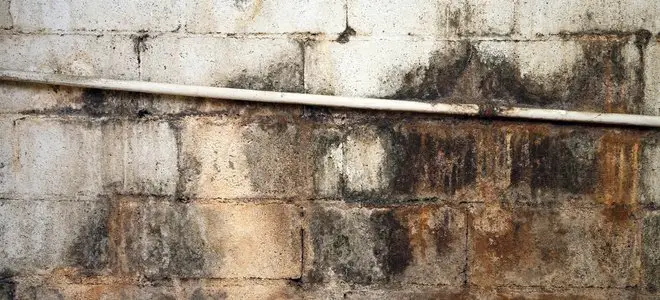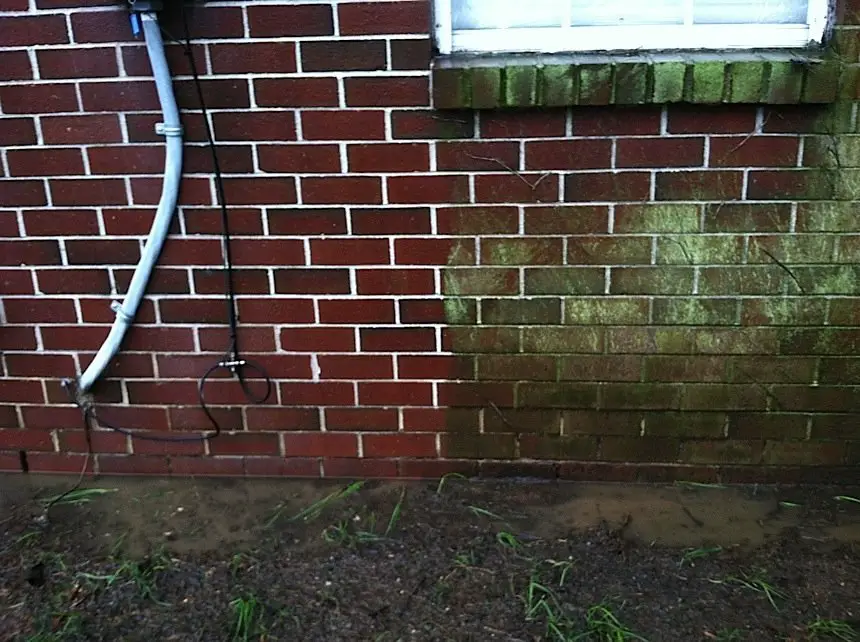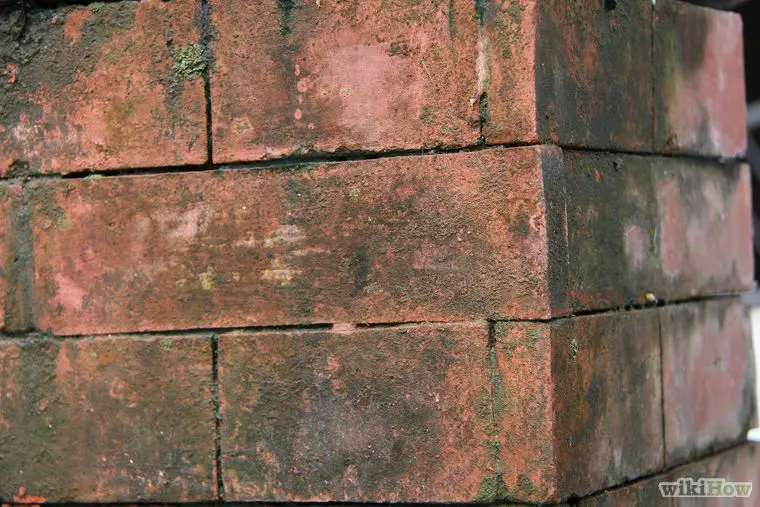How To Clean Mold Off Brick
Written by Batchelder and Collins on October 23, 2019. Posted in Brick, Featured.
Its never fun when mold appears anywhere and seeing it on your brick can be frustrating because mold produces digestive enzymes that eat away at the surface its attached to, no matter the material.
It causes structural damage that can weaken your strong brick home plus touching or ingesting mold spores can cause health problems like asthma, nausea, rashes, or other symptoms. For all these reasons, you want to remove mold from your brick as soon as it appears. The good news: its a fairly easy process. Just follow our step-by-step instructions and your brick home will be mold-free in no time.
Create Your Cleaning Solvent And Apply
There are three effective types of cleaning solvents for brick, including soapy water , a bleach formula , or muriatic acid .
Soap : A basic soap mixture can clean basic stains off of brick. If you dont want to use bleach, then soap and warm water may be enough especially if you live in a dry climate.
Vinegar : Alternatively, some people skip the dish soap and mix a solution with equal parts vinegar and water, then pour it into a spray bottle. This solution can be surprisingly effective at removing basic stains from brick.
Bleach : A bleach mixture is ideal for removing mold, mildew, and moss from exterior brick walls. Combine a tablespoon of bleach with a gallon of warm water in a bucket, then apply the bleach with a sponge to the brick. Use a scrub to tackle hard-to-reach areas or difficult stains. If the bleach begins to dry on the brick, spray a small amount of water on the area to keep it moist. Once the surface has been cleaned, hose down the section of brick using water.
What Causes Mold/mildew To Grow On Bricks
You are guaranteed to see white mold anywhere that water settles and in environments that are moist. This is because white mold needs water to reproduce.
So it tends to enjoy humid places. Inside the home, it can also grow in moist places such as the bathroom and laundry room. However, in order to keep mold out of your home, keep your rooms well ventilated.
This type of mold will also grow where there is little to no air circulation. Mold spores are always floating through the air and if the area inside or outside your home does not have proper circulation, then it is bound to settle and take root.
This type of mold also grows in attics, basements and crawl spaces that have poor air circulation. If you have brick walls inside the home, then you should install attic fans and cross-ventilate your home.
If you are worried about brick walls outside your home, then ensure that you keep the bricks free from dirt and grime.
Mold is inevitable for many homeowners. However, if it iscleaned right away, it will not cause too much damage. It can damage the bricksinside your home. Actually, the longer it is left to its own devices, thebigger the problem will become.
So to prevent damage to your bricks and your home, you should regularly clean your bricks and ensure that it is free of dirt and grime. If you want to eliminate mold outside the home, then a power washer is priceless.
Don’t Miss: How To Clean Mold Between Pavers
How To Get Rid Of Mold + Mildew Stains
Since vinegar kills only 82% of the mold species, then the remaining 18% of persistent strains of mold. You can mix white vinegar with elements like borax, hydrogen peroxide, and baking soda or salt. Try this if white vinegar alone did not cut through the mold successfully even after repeating the cleaning process several times.
However, bear in mind that each component should be separately used when mixing with vinegar, not all of them at a go. Never mix vinegar with bleach because it produces a toxic gas. If one does not work, dont give up yet try the others following the above steps until you successfully manage to eradicate the black mold from your flooring.
Its a good practice to spray vinegar or mop the floor regularly on the clean mold free surface and leave it there to prevent future breakouts. Ventilate your home and fix any leaks to prevent mold from forming again. But if the mold does not break or the area infected is extensive, seek professional black mold cleaner help
How To Use Cleaning Vinegar

Cleaning vinegar can be used undiluted or mixed with water, depending on the job. For tough stains on fabric furniture or clothes, use cleaning vinegar alone on a sponge or rag to wipe away the spot. Undiluted cleaning vinegar can irritate your skin or nails, though, so be sure to wear gloves.
For everyday cleaning jobs, diluted cleaning vinegar will get the job done. Make an all-purpose cleaner by combining two-parts cleaning vinegar and one-part water in a spray bottle. If you dont like the smell of vinegar, you can add a few drops of your favorite essential oil. This DIY cleaner is great for countertops, sinks, bathrooms, stainless steel appliances, and even windows. If you have an extra dirty job to tackle, like a greasy stove top, use the same spray bottle solution but add one tablespoon of dish soap for extra cleaning power then shake to combine.
Don’t Miss: Mold Smell In Basement
Signs Of Mold On Walls
Mold can grow anywhere along an interior wall. But youre likely to see it near the ceiling or floor, or along the edges of the baseboard trim. Its most common in bathrooms, although it can also affect kitchens, laundry rooms, basements, and other poorly ventilated rooms.
Obvious signs that you have a mold problem in your home include:
- A musty or damp smell.
- Cracked and peeling paint.
- Visible mold growth on your walls or ceiling.
- Allergy symptoms worsened by being indoors.
If you see mold growth on the walls within your home even if its only a small patch you should take action immediately. If you dont remove the mold quickly, it will spread and it can become potentially dangerous to your property and your health.
Studies have shown that exposure to mold can cause allergic reactions and poor health. You may experience symptoms such as a runny nose, irritated eyes, and breathing difficulties . Therefore, its essential to take action as soon as you notice any signs of mold.
How To Clean Mold From Concrete
The best solution is to scrub and clean the affected areas with a mold-killing detergent, like RMR-86 Instant Mold & Mildew Stain Remover, or a simple solution of household bleach and water. Be sure to scrub aggressively to get down into the pores of the concrete. Let the detergent or bleach solution soak in for a while to ensure that all the mold is killed. After scrubbing, rinse with a power washer to get all the solid organic matter out of the concrete.
Once you’ve tackled the mold you can add color or an overlay to completely transform your concrete!
Get ideas from these concrete pictures.
Don’t Miss: How To Clean Mold Off Wood Cabinets
Can I Remove Black Mold Myself
If the black mold growth in your home is small enough for you to treat alone, a simple mixture of bleach and water can help. Add one cup of bleach to one gallon of water and apply it to the moldy spots. Apply the cleaner to the mold spot and scrub away the growth. Be sure to dry the area thoroughly when youre done.
Clean Your Bricks With Bleach
Bleach is a potent agent and will clean all kinds of surfaces. It also works very well as an herbicide and will kill off all sorts of vegetation when applied regularly. It can take care of poison ivy, and itll make short work of the moss on your bricks.
Try bleach when sunlight by itself isnt getting rid of the moss itll bring your bricks back to like-new condition. Dont use this option on bricks near a flowerbed the cleaner will kill off your flowers as well as the moss.
- ½ cup of cold water
- Spray bottle
Add equal parts water and bleach to a spray bottle. Spray down all the moss on your bricks with the bleach solution, making sure to coat every bit of it.
Repeat the spraying after the solution dries and repeat the spray down every day for two weeks. Youll have nothing but dead moss after a week or so.
Also Check: Visual Contrast Sensitivity Test Mold
Types Of Mold That Grow On Bricks
While there are various types of mold that can grow on bricks, some are more common than others.
Black mold is probably one of the most common types of mold that you can find indoors or outdoors, however, when it comes to bricks that are used on walls outside or on pavings, white mold seems to be the most common type.
The good news is that by cleaning your bricks with chlorineor bleach and ensuring that they get plenty of sunlight, you can keep thiswhite mold at bay and prevent it from coming back again.
How Do You Stop Algae From Growing On A Brick Patio
Mix 1 cup of chlorine bleach with 1 gallon of water in a plastic bucket. Spray the bricks and nearby vegetation with water from a garden hose to protect them from bleach runoff. Dip a nylon scrub brush in the diluted bleach solution. Scrub the bricks with the bleach solution to discourage algae growth on the patio.
Recommended Reading: How To Clean Mold From Boat Seats
Is Vinegar My Go
Not typically. Like I mentioned above, it doesnt tackle mycotoxins and where there is mold there are mycotoxins. There is only one product that I trust completely to kill both mold spores and mycotoxins. If you are interested, you can check out my favorite product to kill mold and mycotoxins here.
I DO like vinegar for mold prevention however and use it as an after shower spray. Spraying vinegar on wet or damp surfaces like a shower, bathtub, or inside a washing machine is a great way to prevent mold from taking root. In addition, vinegar works great at preventing mold inside toilet tanks when added weekly.
Can You Get Mold On Concrete

Wet conditions can cause mold and mildew growth on outdoor concrete like driveways, patios and steps. This growth usually occurs in damp or shaded areas that don’t receive a lot of sun or heat. Concrete, with all its nooks, crannies and pores, is actually a great incubator for mold. Wet, humid weather with warm temperatures only improves the growing conditions.
Recommended Reading: Cleaning Canvas Awnings Mold
What Kills Mold Bleach Vs Vinegar
· Updated 09/27/2019
Nobody likes finding mold in their home because it is an ugly sight and it is potentially dangerous. The presence of mold can result in extensive property damage as well as serious health effects for those who are exposed. Mold causes structural damage by feeding on common building materials including wood and drywall. These building materials contain cellulose which is an organic material that mold uses as a food source. As the mold eats away at these materials, they become weakened which greatly increases the risk of structural damage. Mold is also a threat to spread to new areas by dispersing its spores.
While property damage is a major concern when dealing with mold, the possible health effects are a bigger cause for alarm. Exposure to the mold spores can lead to negative health effects such as allergic reactions and even asthma or lung infections in extreme cases. The longer you and your family are exposed to mold, the more likely you are to experience health effects and the worse they will become until the mold is removed. Quick mold removal will help protect your health and limit the damage to your property.
When it comes to removing mold, the most common household remedies include bleach and vinegar. Most homeowners will think to use one of these products for cleaning mold but only one of these options is effective. This guide takes a close look at each option to help you remove small amounts of mold more effectively.
How To Remove Mold On Brick Pavers
Brick pavers can make an attractive addition to a home, and their clay-based construction is environmentally friendly. Like other structures in landscaping, pavers may become subject to the effects of mold and other fungi. Mold may appear as a black, brown or dark green slime, accompanied by a strong musty odor.
Don’t Miss: How To Remove Streptoverticillium Reticulum
What Can I Put On My Patio To Stop It Going Green
You cant cover your patio with copper sheets, but you can spray on a liquid solution of copper that will soak into the top surface of the concrete pavers. This copper will stop the growth of the pesky green and black organisms in their tracks. The easiest way to apply the copper is to buy copper sulfate crystals.
How Do You Stop Mold From Growing On Pavers
You cant cover your patio with copper sheets, but you can spray on a liquid solution of copper that will soak into the top surface of the concrete pavers. This copper will stop the growth of the pesky green and black organisms in their tracks. The easiest way to apply the copper is to buy copper sulfate crystals.
Read Also: Get Rid Of Mold Smell In Basement
Can You Use Bleach To Remove Mold From A Patio
The bleach solution is powerful in getting rid of surface stains, algae on the paver patio, mold, and concrete.
Before you begin to use this bleaching solution, you need to make sure that no adjacent grass and plants may get affected by the bleaching solution.
It is important to note that this bleaching solution can cause dizziness if inhaled and irritate your skin. Therefore, it is crucial to put on protective gear.
To use this bleaching solution method, follow this step-by-step guide:
When Not To Use Cleaning Vinegar
Its safe to use cleaning vinegar almost anywhere, but because of its strong acidity it can cause damage to some surfaces. It is not recommended to use cleaning vinegaror white vinegar, for that matteron natural stone, waxed wood, cast iron or aluminum.
While its true that undiluted cleaning vinegar is great for killing some germs, including E. coli, be cautious when using it for disinfectant purposes. Vinegar is not recommended as a disinfectant by the Centers for Disease Control and Prevention because its ineffective at getting rid of some types of harmful bacteria, such as Salmonella.
Don’t Miss: How To Get Rid Of Airborne Mold In House
Cleaning Mold With Bleach
Always use protective gear when cleaning mold.
According to conventional wisdom, bleach kills mold growth. However, this is somewhat of a myth as bleach only kills the mold on the surface without affecting the membrane underneath. You need to kill and remove this underlying membrane to effectively remove the mold growth and prevent it from returning. Bleach cleaners cannot kill this membrane because its chemical structure prevents it from penetrating porous surfaces. This causes the mold membranes to move deeper into the affected surface to hide from the bleach. You should only use bleach to remove small amounts of mold that have formed on non-porous surfaces.
Another problem with using bleach is that it can actually multiply the mold growth. When bleach is introduced to mold colonies, the mold recognizes the bleach as a threat and reacts. Mold can actually use bleach as a food source once it has been exposed which will cause the mold to grow back faster and stronger. Even the EPA advises against using bleach for removing mold. Fortunately, there is another household item that can kill mold.
What Is The Most Effective Patio Cleaner

The best patio cleaner for 2021
Recommended Reading: How To Get Mildew Out Of Vinyl Boat Seats
What Naturally Kills Algae
Grab a brush and some baking soda. Bicarbonate, the active ingredient in baking soda, is an effective spot treatment to help kill the algae and loosen it from the wall. Make sure you really get every last particle free black algae has particularly long and stubborn roots which makes it a persistent strand.
Spray The Area With Soapy Water And Scrub
After waiting, it is time to use a solution of soap and water.
Take an outdoor scrub brush and dip it in the solution.
Scrub the pavers thoroughly. You will have to scrub the areas with more dirt for longer. Put more emphasis on the gaps between each block.
You wont have to scrub hard as the vinegar has done its job to loosen the dirt. That is why using vinegar before scrubbing is a crucial step.
To make your cleaning even easier, use an electric scrub brush. This will take care of the scrubbing for you. The only step up is the professional scrubbing equipment.
If you dont mind bending and have tough, ground-in spots, such as rust, use a paver soap and a drill extension scrubber.
Also Check: Black Mold On Grout
